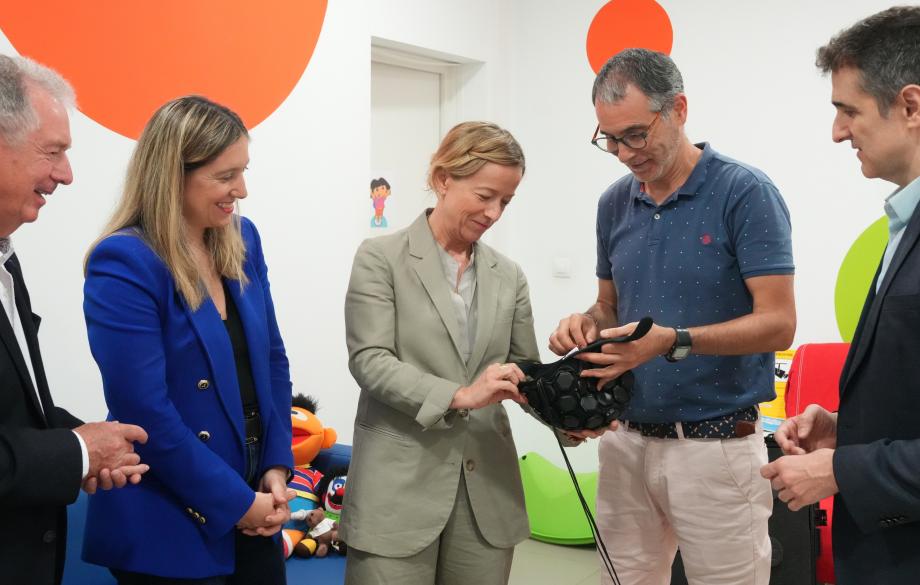BCBL takes another step forward in research on the infant brain and visual system

The research centre has two new advanced pieces of neuroimaging equipment to improve the precision and quality of its studies.
The non-invasive techniques allow BCBL to investigate processes such as language, memory or attention in laboratories such as the BabyLab, where it studies the brain development of babies aged between 0 and 24 months.
The Deputy General, Eider Mendoza, has seen the equipment, financed through the Gipuzkoa Provincial Council’s Science, Technology and Innovation Network Programme.
Technological advances are opening up infinite possibilities in the study of an organ of vital importance to human beings: the brain. Proof of this are the two new neuroimaging techniques available to the Basque Center on Cognition, Brain and Language (BCBL) in San Sebastian.
Specifically, the centre has invested, with the support of the Provincial Council of Gipuzkoa, 137,755 € in the acquisition of new functional near-infrared spectroscopy equipment (fNIRS) and a new Optical Coherence Tomography (OCT).
The Provincial Councillor of Gipuzkoa, Eider Mendoza, accompanied by the Councillor for Economic Promotion and Strategic Projects, Ane Insausti, and the Director of Innovation and Internationalisation, Jon Gurrutxaga, got to know both pieces of equipment and their benefits for BCBL’s scientific work.
Technology adapted to children
On the one hand, the centre’s researchers presented the characteristics of their new fNIRS technology, a non-invasive and easy-to-transport system that is especially adapted to the study of the brain of babies and young children.
“In our BabyLab we will use the new system in experiments with babies aged 0 to 24 months to investigate the neural processes involved in learning and language processing, as well as to improve the accuracy and quality of studies of the effect of a bilingual environment on the brains of children aged 4 to 12 months,” says Manuel Carreiras.
At the same time, the technology can also be used with an adult population to map brain function on an individual basis and observe the variability between healthy subjects and those with neurological pathologies or disorders such as dyslexia in domains such as reading, language comprehension, attention or memory.
“The high resolution achieved by this equipment allows us to compare the results obtained with those observed in functional magnetic resonance studies, with fNIRS being a much more accessible technique,” adds Cesar Caballero.
Identifying markers at the retinal level
On the other hand, the new OCT neuroimaging technique available to BCBL’s research staff positions the centre in Gipuzkoa as a benchmark in its scientific field, as there are hardly any laboratories in cognitive neuroscience that use this technology as an additional tool to explore, investigate and understand key aspects of visual processing such as reading processes.
“The system allows us to identify markers at retinal level to characterise, for example, readers with different visual abilities and to combine the data with information obtained from other BCBL tools to discover new aspects of the visual system,” explains Kepa Paz-Alonso.
The new equipment is also the only one on the market capable of dividing and quantifying the thickness of the retinal ganglion cell layer independently. This is particularly important because this is one of the areas of the visual system most susceptible to changes derived from neurodegenerative processes.
The Provincial Council of Gipuzkoa, a partner of BCBL, has today learned about the benefits of both technologies financed through the 2022 and 2023 calls of the Gipuzkoa Science, Technology and Innovation Network Programme promoted by the Provincial Council.
Mendoza applauded the work carried out by the Gipuzkoa R&D&I network, stressing that “future welfare depends on today’s basic research. BCBL is a world-leading centre that in 15 years of existence has grown in an outstanding way, establishing itself as a node of international talent in which 130 people work, with a very relevant scientific production. Its activity is essential to understand how our language learning or our memory works, to learn more about dyslexia, Alzheimer’s or Parkinson’s disease. In short, to make advances that improve our lives and our health. We are proud of this work, of our research ecosystem, and we will continue to support it because we believe 100% in science.




